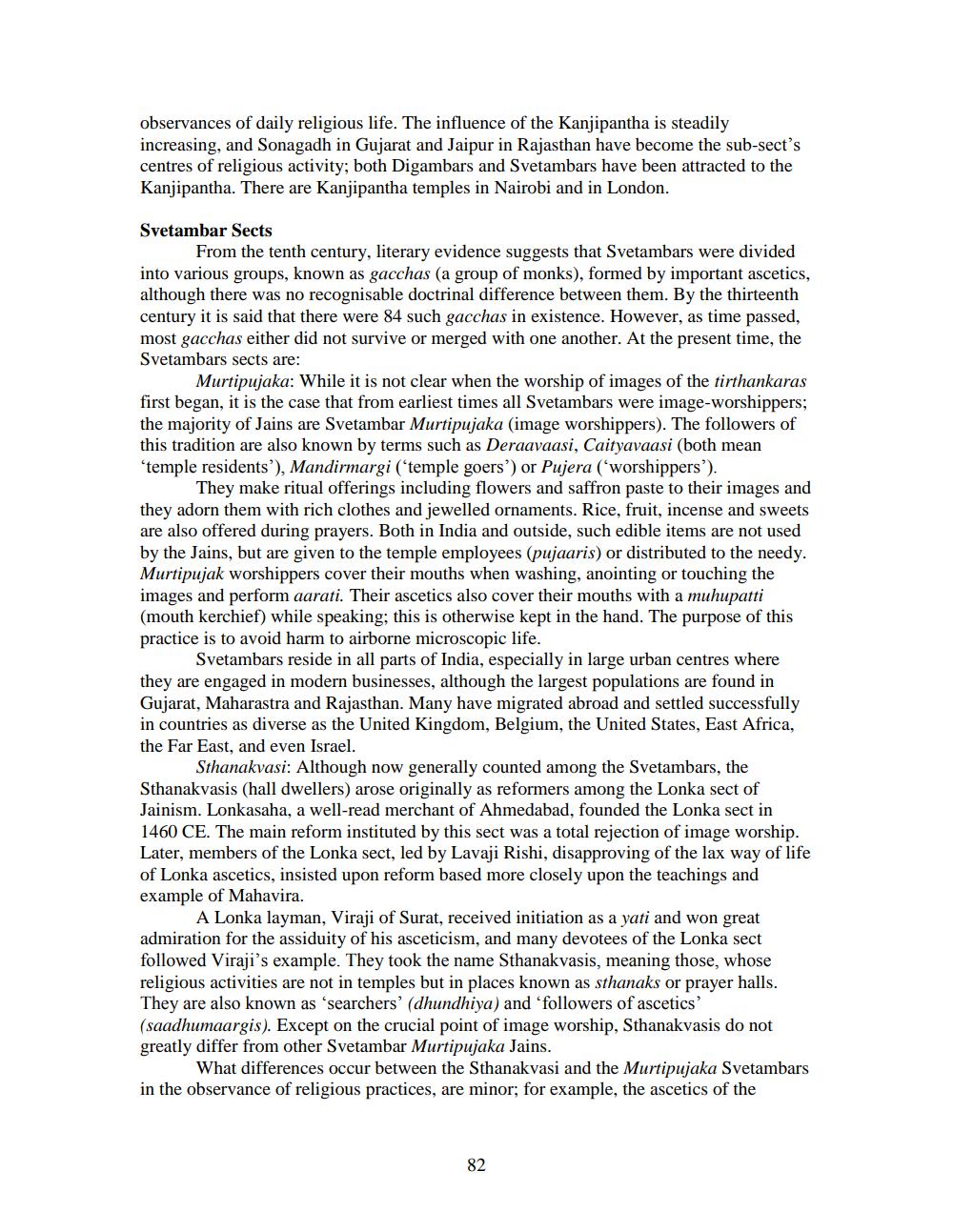________________
observances of daily religious life. The influence of the Kanjipantha is steadily increasing, and Sonagadh in Gujarat and Jaipur in Rajasthan have become the sub-sect's centres of religious activity; both Digambars and Svetambars have been attracted to the Kanjipantha. There are Kanjipantha temples in Nairobi and in London.
Svetambar Sects
From the tenth century, literary evidence suggests that Svetambars were divided into various groups, known as gacchas a group of monks), formed by important ascetics, although there was no recognisable doctrinal difference between them. By the thirteenth century it is said that there were 84 such gacchas in existence. However, as time passed, most gacchas either did not survive or merged with one another. At the present time, the Svetambars sects are:
Murtipujaka: While it is not clear when the worship of images of the tirthankaras first began, it is the case that from earliest times all Svetambars were image-worshippers; the majority of Jains are Svetambar Murtipujaka (image worshippers). The followers of this tradition are also known by terms such as Deraavaasi, Caityavaasi (both mean 'temple residents'), Mandirmargi ("temple goers') or Pujera ('worshippers').
They make ritual offerings including flowers and saffron paste to their images and they adorn them with rich clothes and jewelled ornaments. Rice, fruit, incense and sweets are also offered during prayers. Both in India and outside, such edible items are not used by the Jains, but are given to the temple employees (pujaaris) or distributed to the needy. Murtipujak worshippers cover their mouths when washing, anointing or touching the images and perform aarati. Their ascetics also cover their mouths with a muhupatti (mouth kerchief) while speaking; this is otherwise kept in the hand. The purpose of this practice is to avoid harm to airborne microscopic life.
Svetambars reside in all parts of India, especially in large urban centres where they are engaged in modern businesses, although the largest populations are found in Gujarat, Maharastra and Rajasthan. Many have migrated abroad and settled successfully in countries as diverse as the United Kingdom, Belgium, the United States, East Africa, the Far East, and even Israel.
Sthanakvasi: Although now generally counted among the Svetambars, the Sthanakvasis (hall dwellers) arose originally as reformers among the Lonka sect of Jainism. Lonkasaha, a well-read merchant of Ahmedabad, founded the Lonka sect in 1460 CE. The main reform instituted by this sect was a total rejection of image worship. Later, members of the Lonka sect, led by Lavaji Rishi, disapproving of the lax way of life of Lonka ascetics, insisted upon reform based more closely upon the teachings and example of Mahavira.
A Lonka layman, Viraji of Surat, received initiation as a yati and won great admiration for the assiduity of his asceticism, and many devotees of the Lonka sect followed Viraji's example. They took the name Sthanakvasis, meaning those, whose religious activities are not in temples but in places known as sthanaks or prayer halls. They are also known as 'searchers' (dhundhiya) and 'followers of ascetics' (saadhumaargis). Except on the crucial point of image worship, Sthanakvasis do not greatly differ from other Svetambar Murtipujaka Jains.
What differences occur between the Sthanakvasi and the Murtipujaka Svetambars in the observance of religious practices, are minor; for example, the ascetics of the
82




